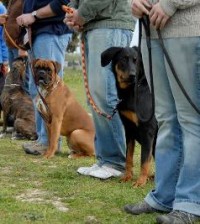- Do you subscribe to Dharma Dog Training’s Newsletter? You should.
- A Unique Campaign from The Humane Society of the United States
- Rabid bats in Omaha- Stay safe, prepared with these tips
- Springtime Activities in Omaha
- Mill Dog Monthly from Bailing Out Benji
- World Spay Day, Legislative Alert in Nebraska
- Attend the Nebraska Rescue Council’s monthly meeting this Saturday
- Five Hard-to-Ignore Reasons to Adopt!
- Paws in Pink to Benefit Breast Cancer Foundation
- VCA, Inc. Acquires MidWest Vet Specialists from Kansas State University
True or False? Banning “dangerous” breeds solves safety concerns

When folks attend events where animals are present- for example, a nature education program or a meet and greet with rescue dogs- there’s an inevitable question the animal handlers are asked: “Does he bite?”
The best answer I’ve heard was from a conservation specialist who, holding a snake, replied, “It’s got a mouth and teeth, so…”
Typically, your dog doesn’t just randomly bite people, right? And typically, snakes don’t just pop up out of the grass looking to latch onto your leg. These things can happen though. Understanding animals, knowing that any of them with a mouth and teeth can bite, is important for everyone.
And when a dog bites, especially one from the stereotypically “dangerous” breeds, the first thing many will say is, “You know, that kind of dog is dangerous,” or, “Why would any own that breed? They’re vicious!” And because of misconceptions and these stereotypes, banning certain breeds is something that is done in many places. Council Bluffs, for example, has banned certain breeds with breed-specific legislation (BSL). Places do this in order to “address safety concerns” that people have. Again, anything with a mouth and teeth can bite, so the logic behin BSL doesn’t work for many people. Others believe certain breeds are more apt to bite than others.
We’ve written about BSL, about perceptions people have of some breeds, and about training (both dogs and people) that’s so important. Kristin Sandstede, owner and trainer at Big Moose Dog Training, was kind enough to comment on BSL, training, and more.
Personally, Sanstede does not support breed bans. “I do not feel that they accomplish the desired goal,” she says about breed-specific legislation, echoing the above thinking that any dog from any breed will bite. “In the right set of circumstances,” she says, “any of them will bite. For some dogs, it’s always the right set of circumstances, which is sad.” Sandstede thinks there are some very specific behavior indicators that help assess risk. “Few, if any, are breed related,” she says.
That said, different breeds were designed for different jobs. And dogs with high prey drive come with certain traits that can be risky. Terriers, as an example, were designed to eradicate vermin. Often it is not recommended that they live with small animals like cats, rabbits, gerbils, etc. It’s not to say that they can’t ever, but we know what Terriers were designed to do. “I’ve known many Terriers that lived with cats, for example,” Sandstede says, “but that’s not to say stray cats or other small animals found in the yard were shown the same ‘kindness.'”
Sight Hounds are another group that comes with suggested precautions. These hounds can live side-by-side with other dogs and/or cats. They can also tap into the atavistic as Chase Reflex kicks in and their pals are no longer seen as fellow dogs, but as prey. Again, this is not an absolute, but we know instinct and genetics tell these dogs to do a certain job.
Whenever we talk about behavior, we need to recognize it is a product of Genetics + Environment, Sanstede says:
Let’s start at the front end: Genetics. Responsible breeders not only have a breeding program designed to produce dogs as close to the physical breed standard as they can (height, weight, bone structure, ear set, jaw set, coat), but to also screen for common health issues (bad hips, eye issues, deafness). In addition, they also breed towards the temperament outlined in the breed standard. Gun dogs need to be able to hold a point while a shotgun is fired over the top of them. Using this standard, sound sensitivity would not be a desired personality trait. Herding dogs need to be able to move a cow into a pen/yard without her calf, so shy or bashful wouldn’t work. Dogs also need a certain level of sociability in order to work with humans as a team. Breeders remove dogs that have A-social or aggressive traits from the breeding program.
Responsible breeders also screen where their puppies are placed. Not all breeds are a fit for all lifestyles. Not all breeds are suited for first-time dog owners. A comparison: a 16-year-old driver is more likely to get in an accident with a high-end sports car than a mini van. Responsible breeders also start the socialization process as early as day three of a dog’s life with things as simple as putting the pups individually on a different fabric blanket outside the whelping box.
Being aware of these genetic traits is important for breeders and dog owners.
The other half of the equation is Environment. The window for socialization closes at 16 weeks. So, people who buy a two-month-old puppy and never take the pup anywhere until all shots/boosters have been completed will end up with a fearful dog who is in Fight or Flight mode most of the time. These pups will behave much the same as a dog who had unpleasant experiences the first 16 weeks of life. There’s also the obvious loving, always provided for environment that’s important to dogs. Food, water, shelter, exercise, social interaction. Balancing inside and outside time. Tethering a dog to something outside can give your dog a potty break without you standing out with them, but studies have shown that dogs that are tied out often have higher frustration than dogs that are not. A frustrated dog is more likely to bite. Make sure you’re doing your part in giving dogs the environment that’s needed.
The other part of the puzzle is training. “Dogs will act like dogs. It is up to us to show them how we would like them to behave, in a manner that is pleasant for the dog,” Sanstede says. Knowing that our dogs are always learning, we should always be mindful of what we are teaching them.
In relation to a recent fatal dog attack, Sanstede says that “We are all aware of how dangerous mob mentality can be. And dogs who live together (even if there are only two) can ‘pack up’ on a new dog, or a weak dog, or a dog having a medical emergency. When it comes to resources, you want to make sure there is enough for everyone to avoid fights.” The referenced dog attack, which left one dog dead after its owner threw a bone to his pack of six dogs, was a “fight waiting to happen,” she says. “When I give high value chew toys, I make sure everyone has their own and either they are all in their own crates or everyone is on their own dog bed, and I am present to ensure nobody decides to ‘taste test’ what was not given to them.”
When Sanstede gets calls of sudden onset aggression from a dog, she always recommends a full vet workup first. Many medical issues can present behaviorally, from arthritis to seizures and tick-borne diseases.
In Sanstede’s professional opinion, knowing these things about genetics, providing a positive, friendly environment, and giving proper training lessens the probability of a too-aggressive and bitey dog. “Breed Bans are not the answer,” she says. “Taking the time to socialize and train your dog is important. And, training takes longer than 4-6 weeks. It’s an ongoing process of teaching and proofing as well as practicing to maintain skills.” In addition, many breeds need a “job” to keep them busy, so whether you find one of the many dog sports to participate in or engage in daily games around the house, they all need purpose in life, like humans do.
Meeting your dog’s daily needs, building a positive relationship, learning how to manage your dog’s environment, and setting them up for success through training are all important pieces to the puzzle on how to reduce dog bites.
Find Big Moose Dog Training, owned by trainer Kristin Sanstede, on Facebook here.
Related Posts
Latest News
-
Choosing the Right Pet for Your Lifestyle
Are you thinking about getting a pet but unsure what...
- Posted 1 day ago
- 0
-
How to Make Your Rescue Pet as Comfortable as Possible
Did you bring home a new pet from a shelter...
- Posted 3 weeks ago
- 0
-
How Having A Pet Can Change Your Life
Having a pet can open your heart in ways that...
- Posted 6 months ago
- 0
-
How To Improve The Life Of Your Senior Pet
Do you have an elderly fur baby and want to...
- Posted 6 months ago
- 0
-
Springtime Activities To Enjoy With Your Furry Friends
Are you preparing for warmer weather and want some ideas...
- Posted 7 months ago
- 0
-
Pros And Cons Of Microchipping Your Pets
Have you considered whether your pets should be microchipped and...
- Posted 8 months ago
- 0
-
The Best New Fun Toys For Dogs And Cats
The Best New Fun Toys For Dogs And Cats Did...
- Posted 9 months ago
- 0






















You must be logged in to post a comment Login